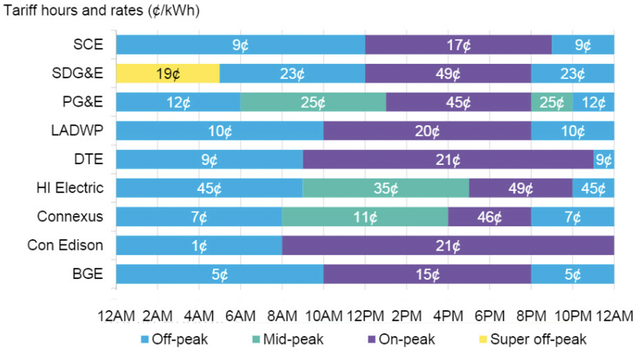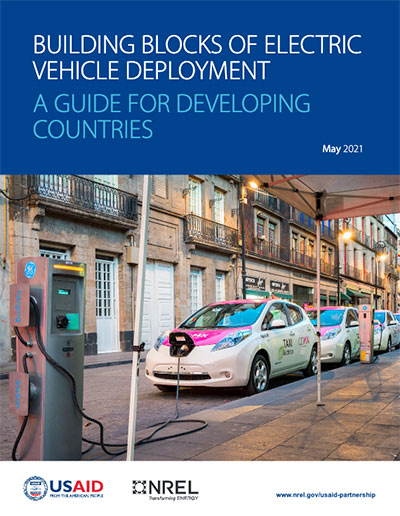Tariff Design
Summary for Decision Makers
Electricity tariffs determine the price customers pay for charging electric vehicles, the business models different investors use to finance and recover the cost of charging infrastructure, and the way in which EVs interact with the grid. EVs can be a large source of flexible load, so regulators can incentive “grid-friendly” charging behaviors by using time-variant electricity tariffs whereby the price of electricity varies throughout the day. Other types of electricity charges, such as demand charges, can be used to recover the fixed costs of EVSE, but are not always appropriate in early-stage markets or for residential customers. In fact, home charging and public charging may require different tariff design approaches and considerations. All EV tariff design will require metering considerations to determine if specialized tariffs require new metering infrastructure.
What Are Electricity Tariffs?
Electricity tariffs specify how electricity consumers are charged for electricity
Electricity tariffs constitute a variety of utility charges that are designed to collect revenue from customers to ensure cost recovery for the utility, fairly apportion the cost of service to different customers, and encourage energy conservation and other “grid-friendly” behavior (Figure 16). In principle, tariffs should be simple, understandable, stable, feasible to implement, and publicly acceptable. 
In the context of EVs and EVSE, tariffs are typically designed between an electric utility, which sells retail electricity, and owners of EVSE, including (but not limited to):
- Residential Customers: Private EV owners who charge their EV at home using their own EVSE.
- Fleets Owners: Private- or government-owned EV fleet customers who may own/operate their own EVSE, such as a taxi or bus fleet.
- Private Charging Service Companies: For-profit commercial enterprises that offer charging services to customers in public spaces.
While certainly possible, it is less common for governments to set customer-facing charges for private charging service companies.
Why Set Special Electricity Tariffs for EVSE?
Tariff design for EV charging can support utility cost recovery associated with hosting EVSE
EVSE are typically larger sources of both peak power consumption and energy use in the power system. Thus, depending on the hosting capacity of the power system, and the exact utilization patterns of the EVSE, it is possible (though not inevitable) that EVSE will be a driver of new utility costs. Tariff design is a critically important tool for ensuring that any new utility infrastructure costs associated with hosting EVSE are fairly recovered.
Tariff subsidies for commercial EVSE developers may be appropriate in early-stage markets
In newer EV markets aiming to introduce public networks of commercial EVSE, decision makers can consider using tariff subsidies as a tool to incentivize deployment. In general, tariff subsidies reduce the rates charged to customers for energy consumption to accomplish various social policy objectives. Subsidies are financed either by tariff increases on customer classes (this is referred to as a “cross-subsidy”) or directly by a government. Tariffs subsidies for EVSE improve EVSE project economics and increase the likelihood of EVSE deployment. Especially in markets with little to no private EVSE deployment, tariff subsidies could be considered. However, subsidies of any kind should be approached with caution as they can be a strain on budgets and can create (or further exacerbate) social inequities. As well, tariff subsidies should be considered in light of other financial incentives that are made available to commercial EVSE developers in order to avoid inefficient use of government or ratepayer funds.
Specialized EV tariffs can influence customer charging behavior and present significant opportunities to ensure “grid-friendly” charging patterns by EV owners
Why should decision makers create specialized EV tariffs that differ from ordinary retail electricity tariffs? While in some cases it may be appropriate to use established retail tariffs to charge EV/EVSE owners, specialized EV electricity tariffs can be used to influence EV customer charging behavior to the benefit of the electricity system by:
- Discouraging EV charging during critical peak times which stress grid infrastructure
- Encouraging EV charging when electricity is less expensive to produce/procure and existing network infrastructure is not fully utilized, and/or when renewable energy resources are available.
With appropriate tariffs, utilities can better manage the new source of demand that originate from EV charging and avoid costly upgrades in network infrastructure associated with unmanaged growth in peak demand. This is often done using time-of-use (TOU) tariffs in which electricity purchases become more expensive during “peak” hours and less expensive during “off-peak” hours.
Design of TOU energy charges for EV charging can take into account a variety of factors
Utilities around the world are implementing TOU energy charges for EVs whereby the price of electricity differs throughout the day to incentivize the timing of EV charging. The following factors can be considered when designing TOU energy charges for EVs:
- System Electricity Demand Pattern: By understanding how electricity demand changes (e.g., on an hourly basis) for the bulk power system over time, decision makers can identify expected periods of peak system demand (e.g., when network and/or generation infrastructure may be stressed) and discourage EV charging during these times. Instead, decision makers can design tariffs to encourage charging during off-peak hours to help defer or avoid expensive peak-driven investments in network or generation infrastructure.
- Localized Electricity Demand Patterns: Related to system electricity demand shape, decision makers can also consider how individual areas within areas of the distribution network are being utilized. If possible, tariffs can be designed to influence charging behavior such that existing distribution network infrastructure can be more fully utilized, and the extent to which new investments in local distribution networks must be made is reduced.
- Resource Availability and Energy Prices: By understanding how the electricity supply mix changes over time (e.g., on an hourly basis), decision makers can identify when lower-cost resources (e.g., solar) are available and design tariffs that encourage charging during those times. Tariffs could also feasibly account for seasonal resource availability, so it is important to understand when abundant, low-cost seasonal resources (e.g., hydropower) are available as well.

While the design of TOU energy charges can in principle consider these aspects, in practice each utility system has unique conditions that warrant different TOU tariff structures to best-manage demand.
Demand charges can help recover fixed network costs associated with hosting an EVSE, but may not be appropriate in all circumstances, especially in early-stage markets and for residential customers
Demand charges—a $ per kW charge for a customer’s peak demand during a billing cycle—can also be considered by decision makers seeking to ensure that their utility is able to recover local network costs associated with hosting an EVSE. Demand charges are typically paid by commercial and industrial customers based on their highest power consumption in each time interval (e.g., 15 minutes or 1 hour) during the billing period. They are not typically implemented for residential customers, as these customers do not tend to have the same level of understanding, visibility, or control over their electricity consumption patterns as commercial and industrial customers; without the ability to understand or respond to price signals offered by demand charges, there is a higher potential for undue cost burdens.
For private EVSE developers, demand charges may be useful to support utility network cost recovery associated with the high instantaneous consumption levels of EVSE. However, especially in earlier stage markets where EVSE utilization levels for EVSE are low, this may be an overly burdensome approach that could hamper EVSE development. In practice, infrequently used EVSE that incur demand charges can lead to significantly higher levelized charging costs than frequently used EVSE that face the same demand charge.
Thus, the implementation of demand charges may create nontrivial cost burdens for EVSE owners in earlier-stage EV markets when EVSE are not being significantly utilized. In these cases, energy charges and fixed charges may be a more appropriate tool to recover utility costs. However, as EV markets mature, phasing demand charges in while reducing energy charges may be a more financially sustainable means of ensuring utility cost recovery from commercial EVSE owners in the long term.
EV tariffs often require new meters to implement
Depending on the metering infrastructure that is already in place, as well as the type of EV tariff being considered, an upgrade to metering infrastructure may be required if a specialized EV charging tariff is to be implemented.
A rollout of new metering infrastructure can come with an additional cost burden to install the meter (which may be borne by either the EVSE owner or the utility), as well as an administrative burden to coordinate installation and ensure that utility billing systems are updated to receive and process oftentimes more complex metering data. In general, decision makers can weigh these burdens against the potential utility and system benefits and can customize their approach to both EV tariff design and EVSE metering requirements by customer class.
Tariff design approaches for home charging and public may have different objectives and considerations
Considerations surrounding desired customer charging behavior, metering infrastructure requirements and costs, utility cost recovery, customer price sensitivity, and expected EVSE utilization levels may drive distinct outcomes for the design of home charging versus public charging tariffs.
Home charging tariff design primarily aims to influence customer charging behavior, steering customers through TOU price signals to charge at more/less desired times to reduce power system operational costs and investment requirements. Charging demand in home environments is more flexible with respect to timing, as drivers may park overnight or for significant periods of time. These longer “dwell times” suggest that residential customers may be more responsive to TOU EV energy charges. However, an upgrade of metering infrastructure for residential customers, either because the existing customer meter cannot collect data on the timing of energy consumption, or because the utility wants to separately meter and track EV charging activities, or both.
Tariff design for public charging (e.g., for commercial EVSE owners offering charging services to the public) is typically attempting to balance:
- Utility cost recovery for hosting the EVSE: tariffs must be sufficient to ensure energy and network costs associated with the presence of EVSE are recovered by the utility.
- Equity concerns for nonparticipating owners: tariffs should ideally not result in an undue cost-shift to ratepayers who do not use or own EVSE.
- Profitability of the commercial EVSE sector: tariffs should ideally not serve as a barrier to commercial EVSE deployment and should enable commercial EVSE to charge reasonable rates to customers.
Charging demand in public applications tends to be less flexible and responsive to time-variant tariffs, as EV drivers typically want to charge immediately, have shorter dwell times, and are not responsible for paying utility tariffs directly if the EVSE is owned by a commercial enterprise. Shorter dwell times and a relative inelasticity of customers to time-variant tariffs suggests that, in the long run, demand charges may be a more effective way to support utility cost recovery.



